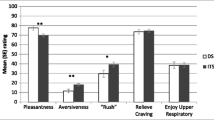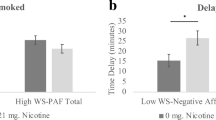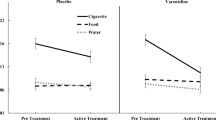Abstract
Rationale
Nicotine patches have been reliably demonstrated to improve smoking cessation outcomes but most users still lapse, and then relapse, during treatment. While patch has been shown to alleviate background cravings, its effects on cue-induced cravings — which have been linked to the occurrence of lapse events — are poorly understood.
Objectives
Here we investigate the effect of nicotine patch on the intensity of craving and negative affect experienced during the hours immediately preceding lapse episodes.
Methods
Participants were 185 smokers who had quit in the context of a randomized, double-blind trial of high-dose (35 mg) nicotine patch and who lapsed at least once during the first 5 weeks of treatment. Participants used electronic diaries to monitor their smoking, affect, and craving during their cessation attempt.
Results and conclusions
The data suggest that developments on the lapse day — either external events or changes in internal states — caused craving and negative affect to rise, cumulating in the lapse. Nicotine is known to lower background craving and negative affect, but the difference between patch and placebo appeared to dissipate in the hours immediately preceding lapse episodes. Understanding the process by which these symptoms "spike" prior to a lapse — and developing treatments to counter it — are worthy research endeavors.



Similar content being viewed by others
References
Cahill K, Stevens S, Perera R, Lancaster T (2013) Pharmacological interventions for smoking cessation: an overview and network meta-analysis. Cochrane Database Syst Rev 2013(5):1–51
Carter BL, Tiffany ST (1999) Meta-analysis of cue-reactivity in addiction research. Addiction 94:327–340
Doherty K, Kinnunen T, Militello FS, Garvey AJ (1995) Urges to smoke during the first month of abstinence: relationship to relapse and predictors. Psychopharmacology 119:171–178
Fagerström KO, Schneider NG, Lunell E (1993) Effectiveness of nicotine patch and nicotine gum as individual versus combined treatments for tobacco withdrawal symptoms. Psychopharmacology 111:271–277
Ferguson SG, Shiffman S (2009) The relevance and treatment of cue-induced cravings in tobacco dependence. J Subst Abus Treat 36:235–243
Ferguson SG, Shiffman S (2010) Effect of high-dose nicotine patch on the characteristics of lapse episodes. Health Psychol 29:358–366
Ferguson SG, Shiffman S, Gwaltney CJ (2006) Does reducing withdrawal severity mediate nicotine patch efficacy? A randomized clinical trial. J Consult Clin Psychol 74:1153–1161
Fiore MC, Jaen CR, Baker TB, Bailey WC, Benowitz NL, Curry S et al (2008) Treating tobacco use and dependence: 2008 Update. Clinical practice guideline. U.S. Department of Health and Human Services, Rockville
Hammersley R (1994) A digest of memory phenomena for addiction research. Addiction 89:283–293
Heatherton TF, Kozlowski LT, Frecker RC, Fagerström K (1991) The Fagerström test for nicotine dependence: a revision of the Fagerström tolerance questionnaire. Br J Addict 86:1119–1127
Hughes JR (1993) Pharmacotherapy for smoking cessation: unvalidated assumptions, anomalies, and suggestions for future research. J Consult Clin Psychol 61:751–760
Hughes JR, Higgins ST, Hatsukami DK (1990) Effects of abstinence from tobacco: a critical review. In: Kozlowski LT et al (eds) Research advances in alcohol and drug problems. Plenum, New York, pp 317–398
Killen JD, Fortmann SP (1997) Craving is associated with smoking relapse: findings from three prospective studies. Exp Clin Psychopharmacol 5:137–142
Muraven M, Baumeister RF (2000) Self-regulation and depletion of limited resources: does self-control resemble a muscle? Psychol Bull 126:247–59
Perkins KA, DiMarco A, Grobe JE, Scierka A, Stiller RL (1994) Nicotine discrimination in male and female smokers. Psychopharmacology 116:407–13
Piasecki TM, Fiore MC, Baker TB (1998) Profiles in discouragement: Two studies of variability in the time course of smoking withdrawal symptoms. J Abnorm Psychol 107:238–251
Piasecki TM, Niaura R, Shadel WG, Abrams D, Goldstein M, Fiore MC, Baker TB (2000) Smoking withdrawal dynamics in unaided quitters. J Abnorm Psychol 109:74–86
Rose JE, Levin ED, Behm FM, Adivi C, Schur C (1990) Transdermal nicotine facilitates smoking cessation. Clin Pharmacol Ther 47:323–330
Shiffman S (1989) Conceptual issues in the study of relapse. In: Gossop M (ed) Relapse and addictive behavior. Croom Helm, Kent, England, pp 149–179
Shiffman S, Ferguson SG (2008) The effect of a nicotine patch on cigarette craving over the course of the day: results from two randomized clinical trials. Curr Med Res Opin 24:2795–2804
Shiffman S, Waters AJ (2004) Negative affect and smoking lapses: a prospective analysis. J Consult Clin Psychol 72:192–201
Shiffman S, Paty JA, Gnys M, Kassel JA, Hickcox M (1996) First lapses to smoking: within-subjects analysis of real-time reports. J Consult Clin Psychol 64:366–379
Shiffman S, Engberg JB, Paty JA, Perz WG, Gnys M, Kassel JD, Hickcox M (1997) A day at a time: predicting smoking lapse from daily urge. J Abnorm Psychol 106:104–16
Shiffman S, Elash CA, Paton S, Gwaltney CJ, Paty JA, Clark DB, Liu KS, Di Marino ME (2000) Comparative efficacy of 24-hour and 16-hour transdermal nicotine patch for relief of craving and withdrawal. Addiction 95:1185–1195
Shiffman S, Ferguson SG, Gwaltney C, Balabanis M, Shadel W (2006a) Reduction of abstinence induced withdrawal and craving using nicotine replacement therapy. Psychopharmacology 184:637–644
Shiffman S, Scharf D, Shadel W, Gwaltney C, Dang Q, Paton S, Clark D (2006b) Analyzing milestones in smoking cessation: An illustration from a randomized trial of high dose nicotine patch. J Consult Clin Psychol 74:276–85
Shiffman S, Brockwell SE, Pillitteri JL, Glitchell JG (2008) Individual differences in adoption of treatment for smoking cessation: demographic and smoking history characteristics. Drug Alcohol Depend 93:121–131
Stead LF, Perera R, Bullen C, Mant D, Lancaster T (2008) Nicotine replacement therapy for smoking cessation (review). Wiley, New York
Stone AA, Shiffman S (1994) Ecological momentary assessment (EMA) in behavioral medicine. Ann Behav Med 16:199–202
Tønnesen P, Paoletti P, Gustavsson G, Russell MA, Saracci R, Gulsvik A, Rijcken B, Sawe U (1999) Higher dosage nicotine patches increase one-year smoking cessation rates: results from the European CEASE trial. Collaborative European Anti-Smoking Evaluation. European Respiratory Society. Eur Respir J 13:238–246
Transdermal Nicotine Study Group (TNSG; (1991) Transdermal nicotine for smoking cessation: Six-month results from two multicenter controlled clinical trials. J Am Med Assoc 266:3133–3138
West R, Hajek P, Belcher M (1989) Severity of withdrawal symptoms as a predictor of outcome of an attempt to quit smoking. Psychol Med 19:981–985
Zeger SL, Liang K, Albert PS (1988) Models for longitudinal data: a generalized estimating equation approach. Biometrics 44:1049–1060
Acknowledgements
This study was supported by research grant DA06084 to Saul Shiffman from the National Institute on Drug Abuse. Nicotine and placebo patches were generously provided by GlaxoSmithKline Consumer Healthcare (GSKCH), which played no other role in the study. Dr. Ferguson is supported through a fellowship from Cancer Council Tasmania (Australia).
Conflict of interest
Through their work at PinneyAssociates, Drs. Ferguson and Shiffman serve as consultants to GSKCH on matters relating to smoking cessation. Dr. Shiffman consults to eRT, which provides ED services for clinical research and is also a partner in a company that is developing a new nicotine medication.
Author information
Authors and Affiliations
Corresponding author
Rights and permissions
About this article
Cite this article
Ferguson, S.G., Shiffman, S. Effect of high-dose nicotine patch on craving and negative affect leading up to lapse episodes. Psychopharmacology 231, 2595–2602 (2014). https://doi.org/10.1007/s00213-013-3429-6
Received:
Accepted:
Published:
Issue Date:
DOI: https://doi.org/10.1007/s00213-013-3429-6




